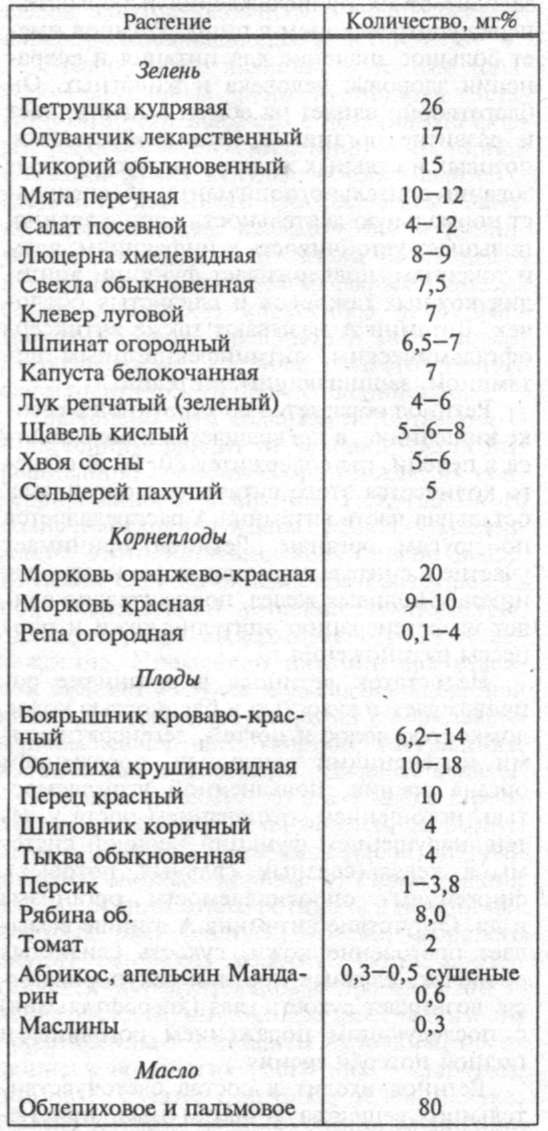Carotene, or provitamin A
Carotene, or provitamin A, is a yellow pigment found in plant foods. It is three times weaker than vitamin A, unstable, destroyed by the action of oxygen in the air, sunlight and heat. Carotene and vitamin A are deposited in the body. The accumulated excess amount of these vitamins can last more than a year, therefore it is expedient to maximize the use of plants containing carotene in the summer-autumn period. The amount of carotene in plants directly depends on the degree of their lining and the content in the leaves of chlorophyll. Plants with a more intense green color, having a large leaf surface, are richer in chlorophyll. In the leaves of plants with yellow, red, orange fruits and root crops there is a large amount of carotene.
Carotene green plants are more active than carotene yellow and orange vegetables and fruits. The high content of carotene is noted in the roots of carrots red-orange, red, fruits of red tomatoes, sea-buckthorn, peaches, red pepper, dogrose, pumpkin (flesh), sea buckthorn and palm oil, greens - parsley, spinach, lettuce, celery, sorrel, Chicory, peppermint, dandelion, alfalfa and pine needles.
The daily requirement of the human body in carotene is 5-10 000 IU (5 mg), i.e. Is equal to the amount contained in 20, 50, 100 grams of red carrots, 100-300 grams of red tomatoes, 25-100 grams of sorrel, 20- 70 g of parsley leaves, 40-130 g of spinach, 35-100 g of green onions, 20 grams of red Pepper, young nettle, 25 g of frozen sea buckthorn berries, ordinary mountain ash, 40 g of dry hips, 100 g of apricot, etc. Carotene spinach has twice the biological activity than carotene carrots, the activity of carotene asparagus is 20% of the activity of vitamin A. 1 mg Vitamin A corresponds to 3300 IU.
As a remedy carotene is prescribed for various diseases of the eyes, liver, atherosclerosis, hypertension, thyrotoxicosis, infectious diseases. Carotene and retinol are needed for pregnant women and nursing mothers for normal nutrition and fetal growth.
The raw materials for the industrial production of carotene are high-caroten varieties of carrots and pumpkins. Carotene is prescribed in undiluted form and in the form of ointments, emulsions (5-10-25-50%). The solution in the oil of a mixture of carotenes isolated from natural sources - carotoline - an extract of carotenoids oily from the flesh of the hips, contains tocopherols, unsaturated fatty acids, etc. (1 ml of the solution contains 2 mg of carotene). It is applied externally in the treatment of trophic ulcers, eczema, atrophic changes in the mucous membranes, certain types of erythroderma (psoriatic, desquamative).
Carotene in food and some other plants:

Chlorophyll-carotene paste , obtained from pine needles, is used to treat burns, sluggish healing wounds, ulcers, colpitis, vulvovaginitis and cervical erosions in the form of bandages, tampons, vaginal douches.


Comments
When commenting on, remember that the content and tone of your message can hurt the feelings of real people, show respect and tolerance to your interlocutors even if you do not share their opinion, your behavior in the conditions of freedom of expression and anonymity provided by the Internet, changes Not only virtual, but also the real world. All comments are hidden from the index, spam is controlled.